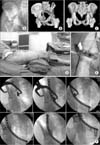Abstract
Purpose
Both column and T-shaped acetabular fractures are frequently presented with difficulty in reduction. Incomplete reduction may cause traumatic arthritis in the hip joint, resulting in inferior clinical outcomes. The purpose of this study is to introduce our wiring technique and to report the clinical and radiological outcomes of such technique.
Materials and Methods
Eight patients who underwent our proposed technique for having acetabular fracture with displaced quadrilateral plate between March 2013 and December 2014 were enrolled. All patients were followed-up more than 1 year. The wire passer was set up from an anterolateral aspect of the iliac crest to the greater sciatic notch, between the abductor muscle and the periosteum. The quadrilateral plate of acetabular fracture was reduced with wiring. Internal fixation was added to the pelvic brim. An analysis of the clinical and radiological outcomes was performed.
Results
Reduction was performed within the 3 mm intra-articular step-off in all patients. The mean duration of union was 11.8 weeks (9-15 weeks). Five patients (62.5%) showed excellent results, and radiologically, three patients (37.5%) showed good results, and seven patients (87.5%) showed better than good results.
Figures and Tables
 | Figure 1The percutaneous cerclage passer consists of 2 dividable forceps that are connected in the middle flat part. When closing the forceps, the tube tips will meet together. |
 | Figure 2(A) Initial radiograph of a 45-year-old male showing both column fractures with a quadralateral plate fracture. (B, C) 3-Dimensional computed tomography scan shows comminuted fracture at both column with medially displaced quadrilateral plate. (D) Supine position with mild knee flexion for iliopsoas muscle relaxation. (E) A large cerclage passer delivers the wire from the iliac crest to the greater sciatic notch with ease and safety. (F) Intraoperative fluoroscopy shows that reduction was performed by pelvic reduction clamp, and cerclage wiring: then reconstruction plate and screws are added for fixation. |
 | Figure 3(A) Immediate postoperative radiograph shows anatomical reduction with cerclage wiring and plate fixation. (B) Radiograph after 12 months after the operation shows union of the fracture site and good joint congruency. |
References
1. Matta JM. Fractures of the acetabulum: accuracy of reduction and clinical results in patients managed operatively within three weeks after the injury. J Bone Joint Surg Am. 1996; 78:1632–1645.
2. Rowe CR, Lowell JD. Prognosis of fractures of the acetabulum. J Bone Joint Surg Am. 1961; 43:30–92.

3. Judet R, Judet J, Letournel E. Fractures of the acetabulum: classification and surgical approaches for open reduction. Preliminary report. J Bone Joint Surg Am. 1964; 46:1615–1646.
4. Gänsslen A, Krettek C. Internal fixation of acetabular both-column fractures via the ilioinguinal approach. Oper Orthop Traumatol. 2009; 21:270–282.
5. Kang CH, Lee KJ, Min BW, Jung JH. Indirect reduction of posterior column through ilioinguinal approach in case of both column fractures. J Korean Hip Soc. 2009; 21:334–338.

6. Kang CS, Min BW. Cable fixation in displaced fractures of the acetabulum: 21 patients followed for 2-8 years. Acta Orthop Scand. 2002; 73:619–624.

7. Kang CS, Min BW, Song KS, Kang CH, Park JW. Cable fixation method for displaced acetabular fracture. J Korean Soc Fract. 1996; 9:574–582.

8. Lin HH, Hung SH, Su YP, Chiu FY, Liu CL. Cerclage wiring in displaced associated anterior column and posterior hemi-transverse acetabular fractures. Injury. 2012; 43:917–920.

9. Matta JM. Operative treatment of acetabular fractures through the ilioinguinal approach. A 10-year perspective. Clin Orthop Relat Res. 1994; (305):10–19.

10. Kim JA, Kim M, Kang SM, Lim KT, Kim TS, Kang JY. Magnetic bead droplet immunoassay of oligomer amyloid β for the diagnosis of Alzheimer's disease using micro-pillars to enhance the stability of the oil-water interface. Biosens Bioelectron. 2015; 67:724–732.

11. Letournel E. Acetabulum fractures: classification and management. Clin Orthop Relat Res. 1980; (151):81–106.

12. Mayo KA. Open reduction and internal fixation of fractures of the acetabulum. Results in 163 fractures. Clin Orthop Relat Res. 1994; (305):31–37.

13. Yoon TR, Jung SN, Park SJ, Song EK. Internal fixation with pelvic plate for displaced acetabular fracture. J Korean Soc Fract. 2000; 13:733–740.

14. Kang CS, Kim SY. The analysis of clinical results of acetabular fractures after open reduction and internal fixation with wire. J Korean Hip Soc. 1989; 1:1–11.
15. Kim CK, Jin JW, Yoon JH, Jung SW, Peang JW. Cerclage wiring in internal fixation of displaced acetabular fractures. J Korean Fract Soc. 2008; 21:95–102.

16. Kim HY, Yang DS, Park CK, Choy WS. Modified Stoppa approach for surgical treatment of acetabular fracture. Clin Orthop Surg. 2015; 7:29–38.

17. Kim JW, Kim YC. Modified Stoppa approach in acetabular fractures. J Korean Fract Soc. 2014; 27:274–280.

19. Tile M, Helfet DL, Kellam JF. Fractures of the pelvis and acetabulum. 3rd ed. Philadelphia: Williams & Wilkins;2003. p. 419–495.




 PDF
PDF ePub
ePub Citation
Citation Print
Print




 XML Download
XML Download